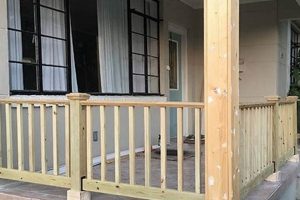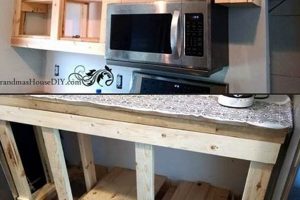Constructing a personalized entertainment system from individual components offers a unique avenue for hobbyists and enthusiasts. This process typically involves assembling a cabinet, integrating a display screen, configuring controls, and installing software to emulate classic or modern games. A tangible example would be sourcing a pre-cut wooden cabinet, installing a joystick and buttons, connecting a monitor, and loading a retro gaming operating system onto a Raspberry Pi.
The importance of creating such a system lies in its customizability and potential cost savings compared to commercially manufactured units. Building a personalized system also provides valuable experience in electronics, woodworking, and software configuration. Historically, the availability of accessible microcomputers and open-source software has democratized the construction process, allowing individuals with limited technical expertise to engage in this project.
The subsequent discussion delves into crucial aspects of this endeavor, encompassing cabinet design considerations, hardware component selection criteria, software configuration best practices, and common troubleshooting techniques. Further attention will be given to legal considerations related to game emulation and distribution.
Tips for Constructing a Personalized Entertainment System
The following provides guidelines designed to optimize the assembly and functionality of a do-it-yourself entertainment system. Adherence to these recommendations can minimize potential complications and enhance the overall user experience.
Tip 1: Cabinet Design and Ergonomics: Prioritize ergonomic considerations during cabinet design. Ensure the control panel’s dimensions accommodate the hands comfortably, and the viewing angle of the screen minimizes eye strain. Mock-ups using cardboard can validate the design prior to committing to final materials.
Tip 2: Component Compatibility: Verify compatibility between all selected hardware components. The power supply must adequately support the power demands of the display, audio amplifier, and computing device. Connector types and wiring conventions should also be compatible to facilitate seamless integration.
Tip 3: Operating System and Emulation Software Selection: Choose an operating system and emulation software suite that aligns with the intended gaming library and computing hardware capabilities. Consider factors such as performance, ease of configuration, and community support when evaluating available options. Retropie and Lakka are examples for Raspberry Pi based systems.
Tip 4: Control Configuration and Mapping: Implement a clear and intuitive control configuration scheme. Test and refine button assignments to optimize gameplay for various emulated games. Utilize software tools to customize input mapping for specific game titles that deviate from standard control schemes.
Tip 5: Power and Ventilation: Proper power distribution and thermal management are crucial. Employ a surge protector to safeguard components from power fluctuations. Incorporate ventilation measures, such as fans or heat sinks, to prevent overheating of the computing device and other heat-sensitive components.
Tip 6: Audio System Integration: Select an appropriate audio amplifier and speaker system to deliver clear and immersive sound. Pay attention to impedance matching between the amplifier and speakers to prevent damage. Route audio cables neatly to avoid interference and ensure reliable signal transmission.
Tip 7: Software Updates and Maintenance: Regularly update the operating system and emulation software to benefit from performance improvements, bug fixes, and new features. Back up system configurations to facilitate restoration in the event of software corruption or hardware failure.
Consistent application of these recommendations fosters a well-designed and functional entertainment system, maximizing enjoyment and minimizing potential technical challenges. Such diligent execution ensures extended operational reliability and heightened user satisfaction.
The subsequent section will discuss some common problems in detail, from electrical to software problems with solutions.
1. Cabinet Construction
Cabinet construction forms the foundational element of any “diy arcade machine” project, directly influencing the overall structural integrity, aesthetic presentation, and ergonomic viability of the completed unit. A poorly constructed cabinet can compromise the playability and longevity, regardless of the quality of internal components. Cause-and-effect relationships are evident in the choice of materials; for example, using thin particleboard may result in cabinet instability and premature failure, while employing robust plywood or MDF provides superior durability. The cabinet provides the physical support and protection for all internal electronics, display, and controls, thus ensuring the operational lifespan of the entire arcade system.
The significance of cabinet design extends beyond mere structural support. Ergonomics, considering the player’s posture and reach, must be carefully considered. For example, an improperly angled control panel or a screen positioned too high or too low can lead to user discomfort and impede the gaming experience. Precise cuts, secure joinery, and thoughtful placement of internal mounting points are crucial for efficient component integration. Real-world examples include the ubiquitous upright cabinet design, optimized for stand-up play, and the cocktail cabinet, designed for seated, two-player simultaneous gaming. These different cabinet styles illustrate the practical application of ergonomic design principles.
In summary, effective cabinet construction is indispensable for a successful personalized entertainment system. Challenges can include material selection, achieving precise cuts, and ensuring structural stability. Overcoming these hurdles leads to a robust and user-friendly gaming platform. Attention to these design and building aspects is crucial in the larger context of creating a functioning and enjoyable “diy arcade machine”.
2. Component Sourcing
Component sourcing constitutes a critical phase in the creation of a personalized entertainment system. The selection and procurement of appropriate hardware components directly impact the functionality, performance, and reliability of the finished product.
- Display Panel Selection
The selection of the display panel dictates the visual fidelity and viewing experience. Factors to consider include resolution, refresh rate, response time, and viewing angle. Examples range from repurposed LCD monitors to specialized gaming displays optimized for low latency. The chosen panel must be compatible with the video output of the chosen computing device.
- Control Interface Procurement
The control interfac
e, encompassing joysticks, buttons, and trackballs, determines the tactile interaction with the system. Components vary in quality, responsiveness, and durability. Sourcing arcade-grade controls ensures authentic gameplay and long-term reliability. Button layouts and joystick types should be selected based on the intended library of games. - Computing Platform Acquisition
The computing platform, typically a single-board computer or a repurposed PC, provides the processing power and software compatibility. Raspberry Pi models are commonly used for their affordability and ease of use. However, higher-performance systems may be required for emulating more demanding games. Software compatibility is a primary concern when selecting the platform.
- Audio System Component Selection
The audio system contributes significantly to the immersive gaming experience. Components include speakers, amplifiers, and audio interface cards. The selection should consider the desired audio fidelity, power output, and impedance matching. Simple powered speakers can suffice for basic systems, while more elaborate setups may include dedicated amplifiers and multi-speaker configurations.
Strategic component sourcing is essential to balancing performance, cost, and build complexity. Careful consideration of each component’s specifications and compatibility ensures a functional and enjoyable gaming experience. Neglecting this phase can lead to performance bottlenecks, compatibility issues, and ultimately, a less satisfying personalized entertainment system.
3. Software Installation
Software installation forms an indispensable step in the creation of a functional personalized entertainment system. The selection and configuration of software define the user interface, game library, and overall system capabilities. Absent properly installed and configured software, the hardware components of a “diy arcade machine” remain inert and unable to provide the intended gaming experience. The process involves installing an operating system, configuring emulator software, loading game ROMs, and customizing system settings. The cause-and-effect relationship is evident; an improperly installed operating system will prevent the system from booting, while incorrect emulator settings can lead to game crashes or graphical glitches. Software is the bridge between the hardware and the end user’s gaming desire.
The importance of software installation extends beyond mere functionality. The chosen software determines the user interface and the ease of navigating the game library. RetroPie, for instance, provides a user-friendly interface and comprehensive emulator support, streamlining the user experience. Recalbox offers a similar solution with a focus on simplicity and ease of setup. These software distributions provide pre-configured environments, significantly reducing the technical expertise required for setup. Selecting the appropriate software, configuring controller mappings, and optimizing performance settings ensure a seamless and enjoyable gaming session. The practical significance lies in transforming a collection of hardware components into a cohesive and readily usable gaming platform.
In summary, software installation constitutes a critical element in the success of a “diy arcade machine” project. Challenges can include compatibility issues, driver conflicts, and configuration complexities. Addressing these challenges effectively transforms raw hardware into a dynamic and user-friendly gaming platform. The understanding of software installation principles is vital for anyone undertaking this project, solidifying the interconnected nature between software and hardware within personalized entertainment systems.
4. Control Configuration
Control configuration constitutes a crucial aspect of personalized entertainment system construction, directly influencing user experience and gameplay accessibility. Without appropriate configuration, the physical controls are rendered ineffective, hindering the ability to interact with emulated games.
- Hardware-Software Interface
Control configuration establishes the necessary link between physical input devices (joysticks, buttons, trackballs) and the emulated software. This involves mapping physical inputs to specific in-game actions. For example, configuring a joystick’s upward movement to correspond with a character’s jump action requires precise software configuration. Improper mapping results in unintuitive or unusable controls.
- Emulator-Specific Settings
Each emulator application often necessitates unique control configuration parameters. Different emulators may interpret input signals differently, requiring adjustments to ensure proper functionality. For instance, the same physical button may need to be assigned different key codes within separate emulator programs to achieve the desired in-game action. These emulator-specific profiles are vital for compatibility across a varied library of retro games.
- Customization and Personalization
Control configuration permits extensive customization to suit individual preferences and gameplay styles. Users can remap button layouts, adjust joystick sensitivity, and create custom control schemes for specific games. This personalization ensures optimal comfort and responsiveness, enhancing the overall gaming experience. The flexibility allows for adaptation to diverse game genres and player dexterity levels.
- Troubleshooting and Optimization
Control configuration frequently involves troubleshooting and optimization to address issues such as input lag, incorrect mapping, or unresponsive controls. Diagnostic tools and configuration utilities are used to identify and resolve these problems. Precise calibration and driver updates can minimize input latency, resulting in a more responsive and enjoyable gaming experience.
These facets of control configuration collectively demonstrate its significance in realizing a functional personalized entertainment system. Careful attention to each of these elements ensures an accessible and enjoyable gaming experience, solidifying the connection between hardware and software within the constructed unit.
5. Aesthetic Design
Aesthetic design constitutes a crucial, albeit often underestimated, component in the construction of a personalized entertainment system. The visual appeal of a “diy arcade machine” significantly influences the user’s initial impression and long-term enjoyment. While functionality remains paramount, a well-executed aesthetic design elevates the system from a mere collection of components to a visually engaging centerpiece. Cause and effect are readily apparent; a professionally designed exterior enhances the perception of overall quality, whereas a haphazard or unattractive design can detract from the gaming experience. The aesthetic design integrates all physical elements into a unified presentation, providing a cohesive and visually pleasing form factor.
The importance of aesthetic design lies in its ability to evoke nostalgia, reflect personal style, and enhance the o
verall gaming atmosphere. For instance, replicating the cabinet art of a classic arcade game, such as Pac-Man or Street Fighter, immediately connects the system with a specific era and franchise, appealing to retro gaming enthusiasts. Alternatively, adopting a modern and minimalist design aesthetic creates a sophisticated and contemporary look, blending seamlessly with modern home dcor. The use of custom artwork, lighting effects, and control panel layouts further personalizes the system, reflecting the owner’s individual tastes and preferences. Successful application of aesthetic design not only enhances the visual appeal but also contributes to the immersive quality of the gaming experience.
In summary, aesthetic design is integral to a successful “diy arcade machine” project. It’s not merely superficial decoration but a fundamental element that contributes to the overall appeal and user satisfaction. The challenges associated with this aspect include material selection, graphic design skills, and the ability to translate a creative vision into a tangible form. A carefully considered and well-executed aesthetic design elevates the system beyond basic functionality, transforming it into a visually compelling and personalized gaming platform, creating a unique product that could be showed and be proud of.
6. Functionality Testing
Functionality testing constitutes a critical stage in the “diy arcade machine” construction process, ensuring that all integrated components operate as intended and in harmony. This process validates the proper execution of all design and assembly efforts. Deficiencies identified during functionality testing necessitate corrective actions to achieve the desired operational state.
- Power System Verification
Verification of the power system entails confirming that the power supply unit delivers adequate voltage and current to all connected components, including the display, computing platform, and audio amplifier. Inadequate power delivery can manifest as system instability, component malfunction, or complete system failure. Multimeter measurements and load testing are common techniques to assess power system performance.
- Display Integrity Assessment
Assessing display integrity involves evaluating image quality, resolution accuracy, and refresh rate consistency. Artifacts such as screen tearing, color distortion, or ghosting indicate potential issues with the display panel, video cable, or graphics processing unit. Calibration tools and standardized test patterns are employed to ensure optimal display performance.
- Control Input Validation
Control input validation entails verifying the accurate and responsive operation of all input devices, including joysticks, buttons, and trackballs. Each input must register correctly within the operating system and be appropriately mapped to corresponding in-game actions. Latency testing and input signal analysis are used to identify and mitigate control input issues. For example, each button press must invoke the intended action without delay or misinterpretation.
- Audio Output Confirmation
Audio output confirmation involves verifying the accurate and consistent delivery of sound through the speaker system. Audio testing should cover a range of frequencies and volume levels to identify potential issues such as distortion, static, or speaker malfunction. Proper wiring and amplifier settings are crucial for achieving optimal audio performance. Silent audio channels, or an inability to adjust the volume, indicates problems that must be addressed.
Functionality testing serves as the final quality control check for a constructed personalized entertainment system. The integration of these testing facets assures that the assembled arcade machine performs as expected, delivering a consistent and enjoyable gaming experience. Thorough testing minimizes the likelihood of post-construction failures and maximizes user satisfaction. Without said testing, the diy arcade machine is mostly useless.
Frequently Asked Questions about diy arcade machine
This section addresses common inquiries and misconceptions regarding the construction of personalized entertainment systems, offering concise and informative responses.
Question 1: Is prior technical expertise necessary to construct a personalized entertainment system?
While prior experience in electronics, woodworking, and software configuration is beneficial, it is not strictly required. Numerous online resources and tutorials provide guidance for novice builders. Starting with simpler designs and gradually increasing complexity is recommended.
Question 2: What are the primary legal considerations regarding game ROMs and emulation?
Distributing or possessing copyrighted game ROMs without authorization is illegal in most jurisdictions. It is generally permissible to emulate games for which one possesses the original physical media. Consult applicable copyright laws and licensing agreements to ensure compliance.
Question 3: What is the typical cost associated with building a personalized entertainment system?
The cost varies significantly depending on the quality of components, cabinet complexity, and desired features. A basic system can be constructed for several hundred dollars, while more elaborate systems may exceed one thousand dollars. Budgeting for potential unforeseen expenses is advisable.
Question 4: What are the most common troubleshooting challenges encountered during construction?
Common challenges include wiring errors, component incompatibility, software configuration issues, and overheating problems. Systematic troubleshooting, utilizing diagnostic tools and online resources, is essential to resolving these challenges.
Question 5: Which operating systems are best suited for personalized entertainment systems?
Several operating systems are well-suited, including RetroPie, Recalbox, and Lakka. These distributions are specifically designed for retro gaming and provide pre-configured environments for emulating a wide range of classic game consoles and arcade systems.
Question 6: How can input latency be minimized in a personalized entertainment system?
Minimizing input latency requires optimizing several factors, including display response time, control interface responsiveness, and software configuration settings. Utilizing low-latency display panels, wired control interfaces, and carefully configured emulator settings can significantly reduce input lag.
This FAQ serves to clarify common concerns, thereby facilitating a more informed decision-making process for potential builders of personalized entertainment systems.
The subsequent section will transition to detailed information on how to prepare for the contruction.
Conclusion
The preceding exploration of the “diy arcade machine” domain has illuminated the multifaceted considerations inherent in constructing a personalized entertainment system. From cabinet design and component sourcing to software installation, control configuration, aesthetic design, and functionality testing, each stage demands careful planning and execution. The creation of such a system requires a blend of technical proficiency, artistic sensibility, and unwavering dedication.
The enduring appeal of the “diy arcade machine” lies not only in its capacity to recreate classic gaming experiences but also in its
embodiment of the maker spirit, fostering creativity, problem-solving skills, and a profound appreciation for the intricacies of hardware and software integration. As technology continues to evolve, the possibilities for customization and innovation within the “diy arcade machine” realm remain boundless, ensuring its continued relevance as both a nostalgic pastime and a testament to individual ingenuity. Further advancements may lead to more streamlined construction processes, enhanced emulation capabilities, and innovative integration of modern gaming technologies.






![DIY Install: Top-Rated Best DIY Gutter Guards - [Year] The DIY Hub: Creative Crafts, Repairs & Life Hacks DIY Install: Top-Rated Best DIY Gutter Guards - [Year] | The DIY Hub: Creative Crafts, Repairs & Life Hacks](https://craftingdiycenter.com/wp-content/uploads/2025/07/th-5757-300x200.jpg)
